Theories and Frameworks of Leadership
Categorising Leadership Theories
Ask anyone what leadership means to them and you will be sure to get a diverse range of answers. In fact, there is no universally agreed description of what it means to be a leader; but this doesn’t mean you can’t learn to be an effective one. Over the years a variety of different theories have been created in an attempt to understand leadership and the characteristics of successful leaders. Understanding these theories will help you on your journey to becoming an effective leader. These theories can be separated into four core groups.
- Trait Theories
- What type of person makes a good leader?
- These theories identify traits (external behaviours determined by our internal beliefs and processes) and qualities that are helpful as a leader. Displaying these traits does not guarantee success as a leader.
- Behavioural Theories
- What does a good leader do?
- Leaders display different behaviours and the different types of behaviour affect performance in different ways.
- Examples: Kurt Lewin's Leadership Styles, the Blake-Mouton Managerial Grid or Transactional and Transformational Leadership.
- Contingency Theories
- How does the situation influence good leadership?
- Best leadership is dependent upon the situation and how it interacts with underlying personal traits. These theories predict which style or traits are best suited for a given circumstance.
- Examples: Path-Goal Theory, Fiedler’s Contingency Model, The Leadership Matrix or Goleman’s Emotional Leadership.
- Power and Influence Theories
- What is the source of a leader’s power?
- These theories look at how leaders use power and influence to get things done.
- Examples: French and Raven’s Six Forms of Power.
In the following section, we will explore the prominent leadership theories discussed above. Please note that two theories, French and Raven’s Six Forms of Power and Transformational Leadership are discussed in depth on separate pages. Further articles discuss emotional intelligence and adaptive leadership.
Discover Behavioural Leadership Theories
Kurt Lewin’s Leadership Styles
First proposed in 1939 by psychologist Kurt Lewin, this framework is based around decision making and identifies three major styles of leadership. It remains a popular theory for understanding the basis of leadership and forms the basis of many subsequent theories. The three proposed styles of leadership are:
Autocratic
The leader is in charge of the whole decision-making process and they will take decisions without consulting their team. This style is appropriate where quick decisions are required, when team agreement isn’t necessary for a successful outcome or where the decision wouldn’t change as a result of team input. Autocratic leadership is often demoralising, leads to high levels of staff turnover and causes discontent.
Democratic
The leader involves team members and guides discussions on the decisions that need to be made. Final decisions are made solely by the leader or as a result of group consensus. This can be difficult to manage when there are a lot of different perspectives and ideas or when there is no clear way of reaching an equitable final decision. It may take some time for a decision to be made but it encourages creativity and results in high job satisfaction and productivity.
Laissez-Faire
The leaders input in decision making is minimised while teams are allowed the freedom to make most decisions and set their own deadlines. Leaders remain responsible for the outcome and may provide support or advice. It works well when the team is highly capable, motivated and doesn’t need close supervision or central coordination. It can result in high satisfaction but will fail to deliver if individuals are unable to manage their time or lack skills and motivation.
Blake-Mouton Managerial Grid
Developed in 1964 by management theorists Blake and Mouton, this theory recommends one of five leadership styles depending upon the balance of two factors; the concern for people (i.e. their needs, interests and areas of personal development) and concerns for results (i.e. concrete objectives, organisational efficiency and high productivity). This theory has been updated with the addition of two extra leadership styles. All seven are described below.
The Blake-Mouton Managerial Grid provides a starting point for leaders beginning to think about their performance, however it is far from the perfect solution. Leadership theory has progressed significantly since its first inception and there are multiple alternative competing theories which provide help to the developing leader and offer guidance on selection of leadership styles. As such, this is only one part of the puzzle.
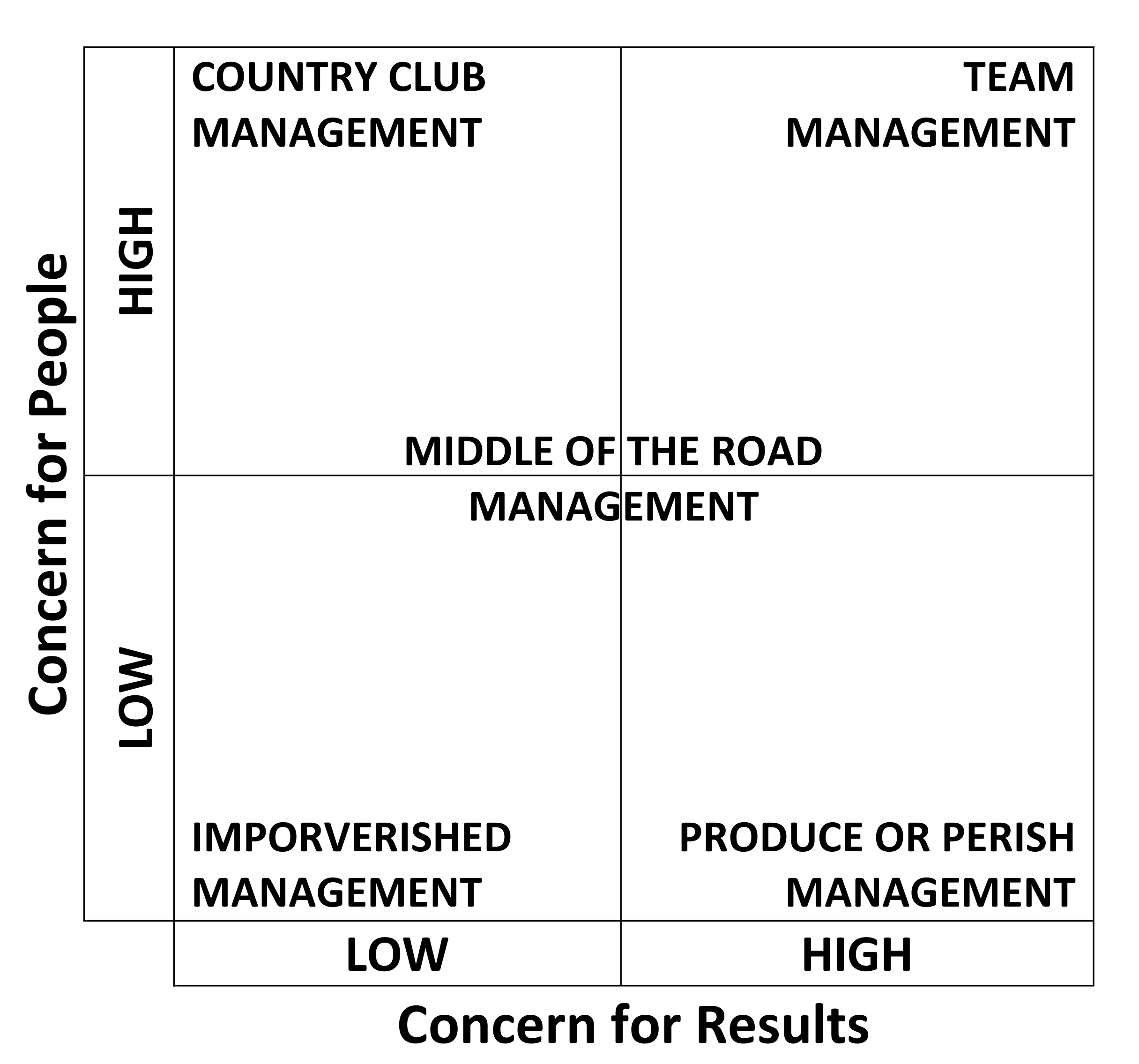
- Impoverished Management (Indifferent)
- These managers display low concern for both getting the job done and supporting or motivating the team. It is used to protect their position and avoid being held responsible for any mistakes. This style is mostly ineffective and is characterised by disorganisation, dissatisfaction and disharmony.
- Produce or Perish Management (Dictatorial)
- These managers believe their team are a means-to-an-end. They will use rules and punishment to motivate staff and achieve their goals. This style is characterised by low motivation, poor morale and exodus of high performers.
- Middle of the Road Management (Status Quo)
- These managers attempt to strike a balance between results and individual’s needs. Unfortunately, this approach is often ineffective and continual compromise fails to inspire high performance while also failing to meet the needs of individuals. It is characterised by mediocre performance.
- Country Club Management (Accommodating)
- These managers are most concerned about their teams needs and feelings. They hope that creating a happy team will improve their performance. It is characterised by a relaxed and fun working environment, but productivity and direction are often lacking.
- Team Management (Sound)
- These managers pay attention to both their team and the results. They will inspire their teams and promote both teamwork and commitment. Team members understand the team direction, have a stake in its future and feel both empowered and respected. It is characterised by hard working and highly motivated teams that stretch themselves to produce great results.
- NEW: Opportunistic
- These managers do not have a fixed location on the grid. They adopt the behaviour which offers the greatest personal benefit and will seek to exploit and manipulate their team members in order to achieve this.
- NEW: Paternalistic
- These mangers do not have a fixed location on the grid but will alternate between the Country Club Management (Accommodating) and Produce or Perish Management (Dictatorial) styles. These managers may be supportive and encouraging but will also protect their own position. They both instruct and guide team members, but don’t take kindly to being questioned.
Transactional and Transformational Leadership
First proposed by James Burns in the 1978, the theory of Transactional and Transformational Leadership is based on two mutually exclusive leadership styles. He believed leaders belong to one of two leadership styles, transactional or transformational leadership. We describe both styles below.
Transformational Leadership
Transformational leaders inspire their team by presenting a strong vision for the organisation and setting goals to make it a reality. They believe that team members can transform and continually evolve as individuals to reach higher levels of performance. Transformational leaders achieve this by placing individuals just beyond their comfort zone through careful use of goals that become more challenging or use increasingly tight deadlines. Leaders and team members work together to find the need for change, create the vision for the future and motivate one another towards higher levels of performance. Constant course correction ensures the vision remains on path to becoming a reality. Visit our article on Transformational Leadership to read more.
There are four different components of transformational leadership. They are collectively known as the four I’s. They are briefly outlined below:
Idealised Influence
The leader serves as a role model and will lead by example by embodying the qualities they want to see in their team.
Intellectual Stimulation
Leaders create a diverse and open environment in which individuals are encouraged to innovate and think for themselves.
Inspirational Motivation
The leader clearly articulates their expectations and inspires followers to achieve high (yet reasonable) goals.
Individualised Consideration
Leaders demonstrate genuine concern for the needs and feelings of their team and will provide a caring and supportive environment.
Transactional Leadership
Transactional leaders use rewards and/or punishments to shape the actions of team members toward the completion of pre-determined goals. They rely on clarity, careful organisation and close supervision of performance. Individuals are rewarded for the precise work they do and are punished for mistakes or undesirable actions. Leaders create achievable goals for team members of all capabilities and incentives are used to motivate individuals to maximise their productivity. Leading in this way fosters a clear structure in which everyone knows their role and results in a system that is easy to understand where motivation is readily visible.
While transactional leadership may work well in certain situations, it is not without its disadvantages. Individuals are encouraged to do only what they are compensated for, thus only complete the bare-minimum work. They are afraid of being punished for mistakes and will therefore take fewer risks. This limits innovation and reduces opportunities to develop new skills or promote individuality. Disciplinary action places blame on individuals and leads to high levels of dissatisfaction. Finally, this leadership style does not create leaders from within the team.
Discover Contingency Leadership Theories
Path-Goal Theory
Developed in 1971 by House and Mitchell, the path-goal theory assumes that leaders must be flexible and choose different types of leadership behaviour depending upon the particulars of a situation. Their choice of behaviour will affect the attitudes and behaviours of their team. The path-goal theory describes a method to identify the best leadership approach based upon individuals’ characteristics, the task at hand and the environment in which they operate. Environmental factors are outside the control of individuals and therefore determine the type of leadership behaviour required in order to maximise individual performance. Meanwhile individual characteristics describe the experience, locus of control and perceived ability of team members. These characteristics determine how the environment and leader are interpreted. Together, these factors impact the attitudes and behaviours of the team. The four possible leadership behaviours are described below:
Supportive
The leader focuses on relationships and pays attention to the needs of their team members. They are friendly, empathetic, offer support and treat others with respect. This style works well in repetitive or stressful tasks where there may be elements of psychological or physical distress.
Directive
The leader communicates clear goals and expectations. Leaders know what must be done and how tasks should be completed in order to meet goals. They closely monitor their team to ensure adherence. This style works well with inexperienced teams or when completing ambiguous unstructured or complex tasks.
Participative
The leader focuses on participation of team members in decision making. Leaders consult the team and involving their ideas and expertise when making decisions. This style works well with experienced teams that are tackling complex and challenging tasks.
Achievement-Oriented
The leader sets challenging yet achievable goals. They expect their team will maintain high standards of performance and will display their confidence in the ability of their team to achieve these goals. This style works well for team members who are independent and have good problem-solving abilities. It may also work with an unmotivated, unchallenged or bored team.
Each of these leadership styles allows the leader to guide team members and help them choose the best paths (behaviours and actions) in order to achieve both individual and organisational goals. The leader must remove barriers and help their team members achieve their goals by providing both direction and support as needed, including rewards. Leaders will engage in behaviours that complement team members’ abilities and compensate for deficiencies in both individuals and the environment, both positively affecting satisfaction and performance. The ultimate aim is to increase an individual’s motivation, empowerment and satisfaction so they become a productive team member. The central role of a leader is to help the team define and reach their goals in an efficient manner.
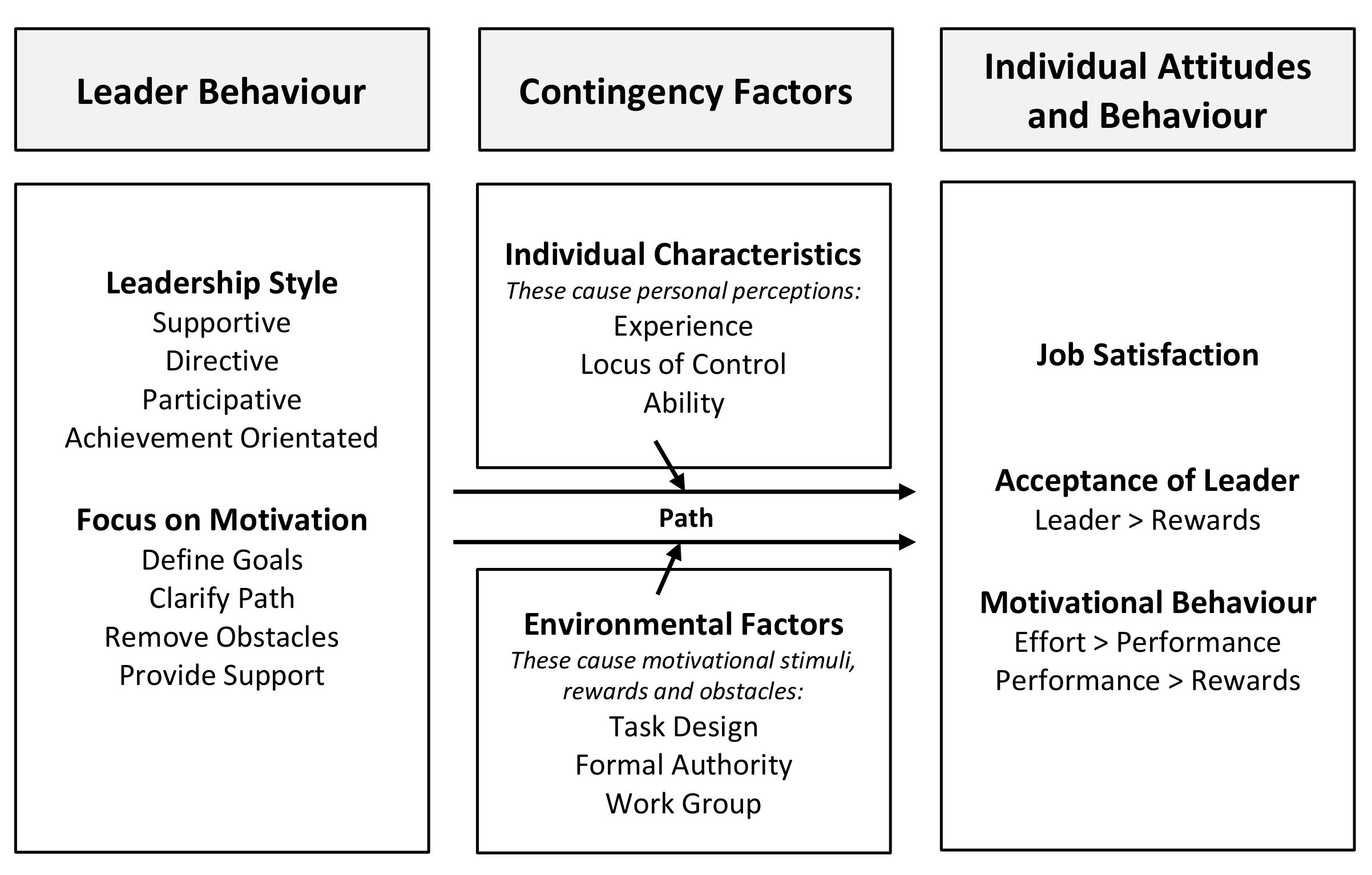
Fiedler’s Contingency Model
A contingency is a situation or event that is dependent on someone or something else. This model was created in the 1960s by Fred Fiedler. It states that there is no best style of leadership, rather leadership effectiveness is based on the situation and is the product of two factors; leadership style and situational control. This model is highly criticised for its view of fixed leadership styles necessitating a change in leader to ensure effective management of different situations.
Furthermore, the Least-Preferred Co-Worker (LPC) Scale (described below) is highly variable and therefore unreliable. Nor does the LPC scale clearly differentiate respondents with scores falling in the middle rendering them unable to identify their leadership style. Criticisms aside, the Fiedler’s Contingency Model is described below.
Leadership Style
Leadership style can be measured using a scale known as the Least-Preferred Co-Worker Scale. This scale asks you to score how you felt about a person you least enjoyed working with. A high score suggests you are relationship-orientated, while a low score suggests you are task orientated. Scores are interpreted as follows:
- ≤ 54: Task Orientated
- 55 – 72: Mixed. You can decide which style suits you best
- ≥ 73: Relationship Orientated
- Relationship Orientated (high-LPC) leaders
- Focus on personal connections, are good at avoiding or managing conflict and make better complex decisions.
- Task Oriented (low-LPC) leaders
- Effective at completing tasks, quick to organise a group and get tasks or projects done.
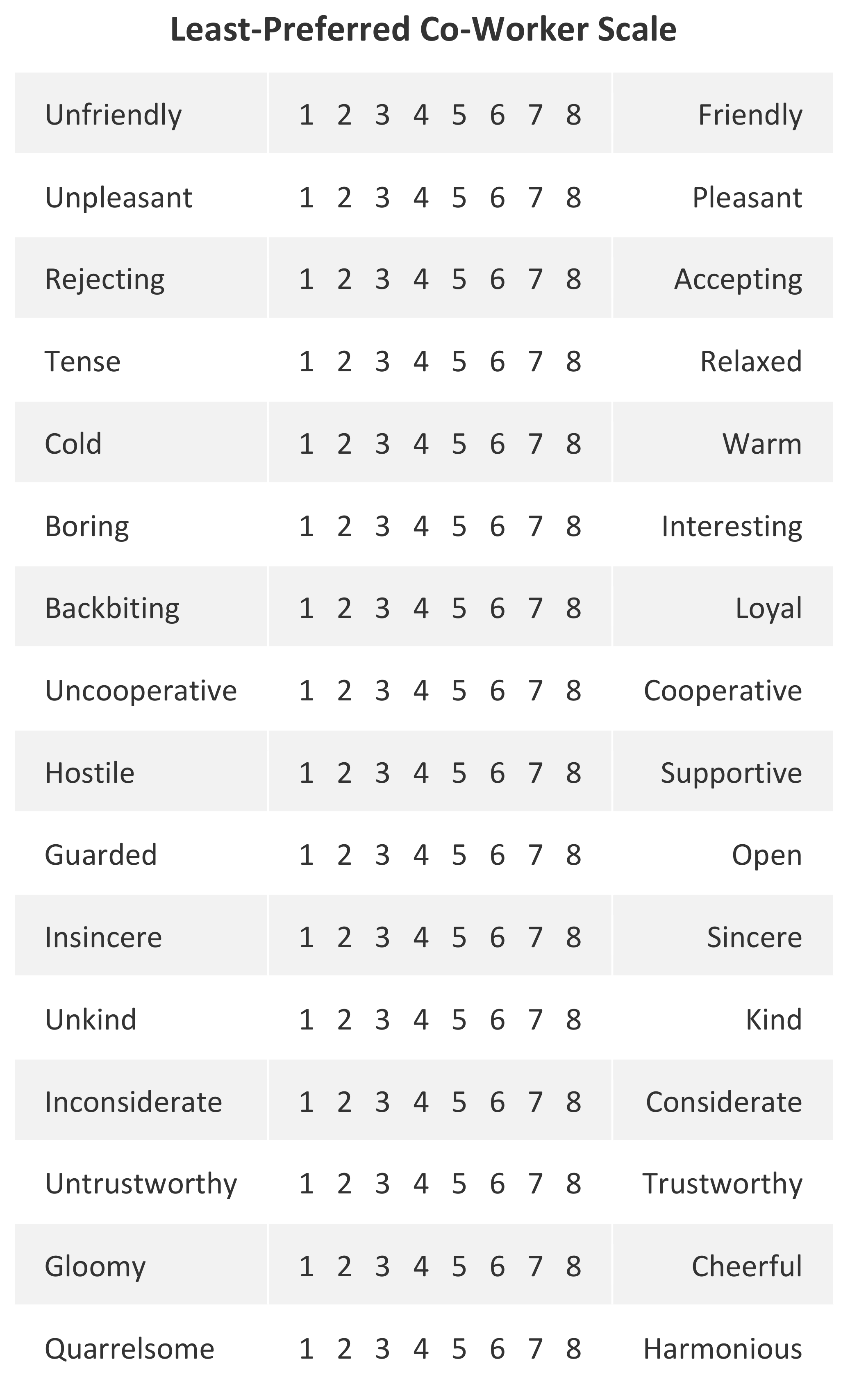
Situational Control
There are three distinct factors to consider for your situation:
- Leader-Member Relations: The level of trust and confidence your team has in you. The more trusted and influential leaders are viewed more favourably.
- Task Structure: This is the type of task. It is either clear and structured or vague and unstructured. The former is viewed more favourably.
- Leaders Position Power: This is the amount of power you have to direct the group and provide reward or punishment. More power is more favourable.
Once you have identified your fixed leadership style (using the LPC scale), you can identify which leadership style would be most suitable for your current situation by assessing the situational control factors and interpreting with the table below. Using this information you will then be able to place the most appropriate leader.
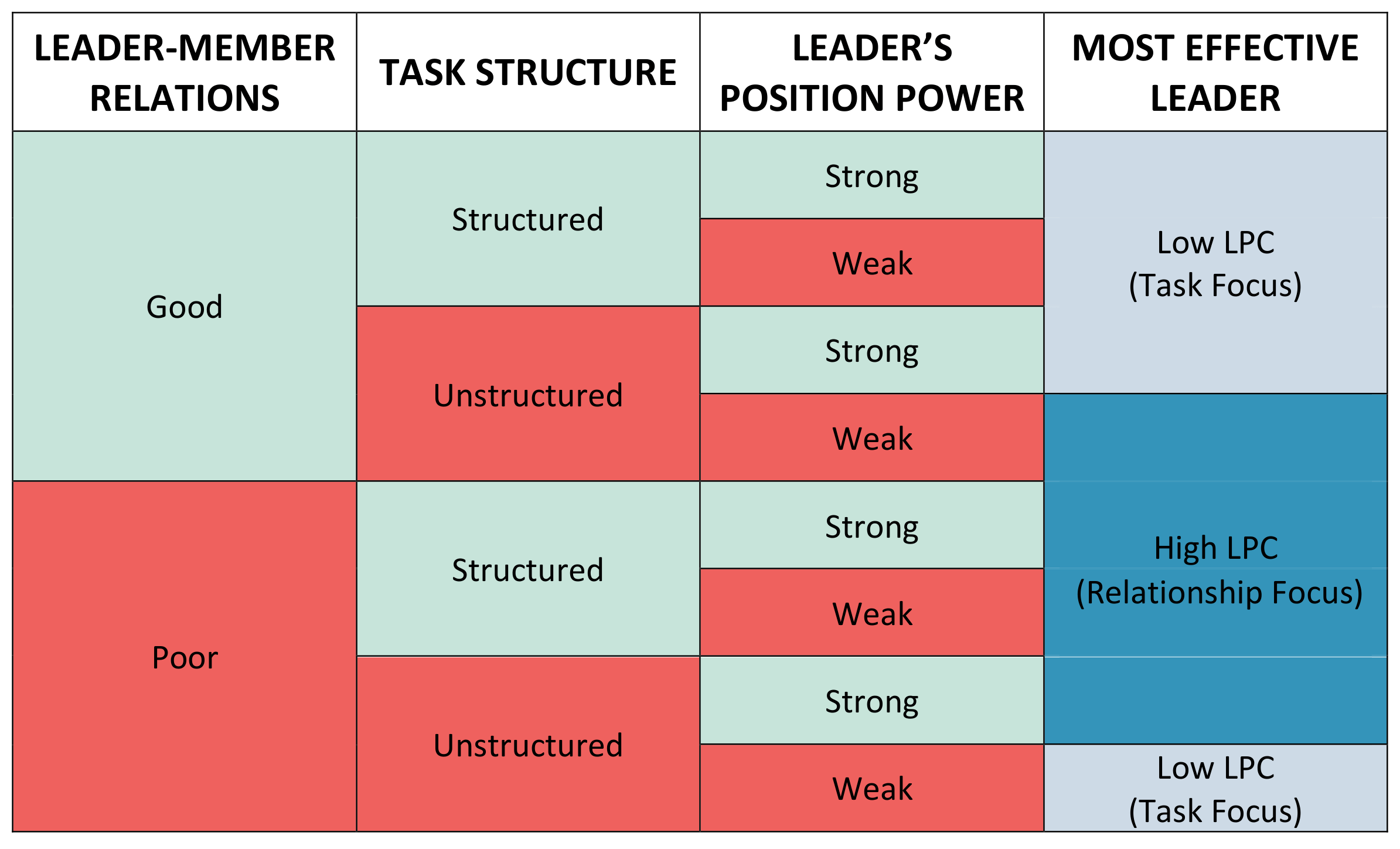
Leadership Style Matrix
The leadership matrix was developed by Flamholtz and Randle in 2007 and is described in their book “Growing Pains”. Their theory is based on the premise that leaders can use different leadership styles depending upon the situation. They propose six different leadership styles as follows:
Autocratic Leadership
Leaders make decisions without consultation and without explaining decisions to their team. It works well when quick decisions are needed or when a process must be completed in a specific way.
Benevolent Autocratic Leadership
Leaders make decisions without consultation but will explain the reasons for taking them and how the decision is best for the organisation.
Consulting Leadership
Leaders interact with their team and will ask for opinions or answer their questions. The leader makes the final decision.
Participatory Leadership
The team develops the ideas, but the leader will still make the final decision. The leader may raise questions or problems with the team to improve their decision-making ability.
Consensus Leadership
The team makes the decision and decides direction.
Laissez-Faire Leadership
Team has responsibility for completion of tasks. It works well with highly motivated and qualified team members. The leader will follow up to ensure everyone is working the right way.
While researching the types of leadership displayed by successful entrepreneurs, they also noted that organisational leadership has two relevant points:
Strategic Leadership
Focuses on vision, culture and organisational development.
Operational Leadership
Aimed at managing daily actions of companies and the people who produce services and products.
The Leadership Style Matrix proposes a method to select the most appropriate leadership style. It is divided into four quadrants with each quadrant listing two leadership styles that are best suited dependent upon two dimensions; programmability of tasks and individual capability. According to this theory, these two factors account for 80-90% of considerations when selecting a style. Programmable tasks are those with specific steps or instructions, while non-programmable tasks require the individual to decide how it should be accomplished. Individual capability describes the preference for autonomy. Autonomy tends to increase with education, skill, motivation, desire for feedback, interaction or independence. Once you have decided which quadrant your situation falls into, you may select your leadership style. The four quadrants are described below:
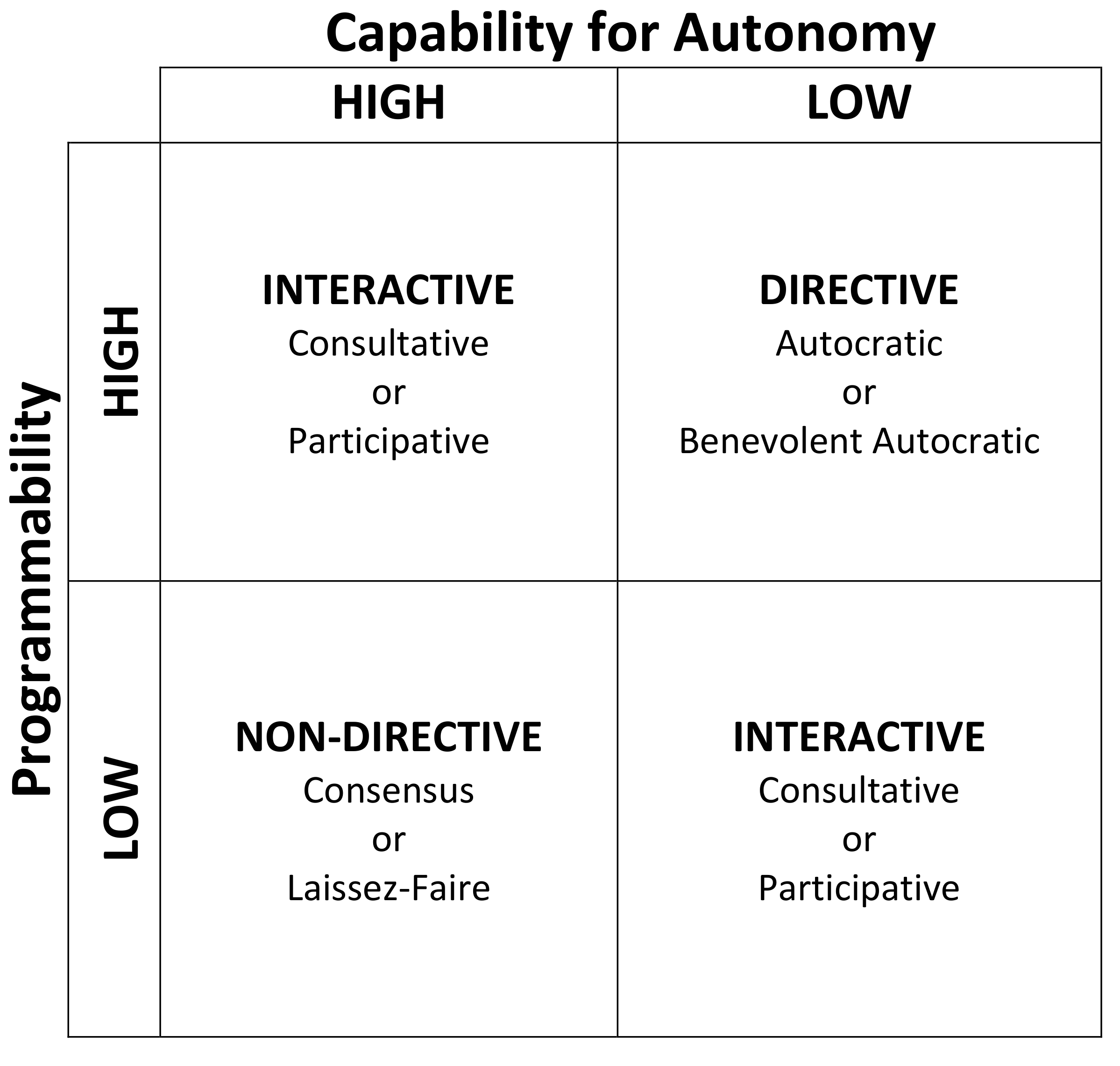
- High Programmability with Low Autonomy
- Autocratic and Benevolent Autocratic. Leader must be in charge of a task that needs specific completion. The focus should be on managerial leadership to make the process more efficient.
- High Programmability with High Autonomy
- Consultative and Participatory. Resolves tasks and conflicts using brainstorming, but leader always has final decision.
- Low Programmability with Low Autonomy
- Consultative and Participatory. Team members need direction, input and interaction as they do not have autonomy.
- Low Programmability with High Autonomy
- Consensus and Laissez-Faire. Creative projects require freedom and independence. Leaders use a non-managerial approach.
Implications
The Leadership Style Matrix is an efficient and practical method for selecting the leadership style needed as determined by the task at hand and the individuals involved. It allows for success by encouraging leaders to adapt their style to the necessary tasks, while recognising the experience of team members and the varying degrees of autonomy this should allow them.
Tasks which are well described and performed in a scheduled manner can be done with less supervision, more confusing tasks will need a more participatory leadership style and if the individuals are inexperienced, then a guiding hand is necessary.
Six Emotional Leadership Styles
Daniel Goleman identified six emotional leadership styles from his research on 3,871 executives in 2000 and further explored them in his book “Primal Leadership”. Each style is uniquely defined and can be correlated with the effect they have on the company climate with obvious implications for results. The six styles can be split into two groups, those promoting harmony with positive outcomes and those which create tension.
Visionary
Coaching
Affiliative
Democratic
Pacesetting
Commanding
A leadership style should be viewed as a tool and not a personality trait. Each style fits a different situation, and a good leader should be able to use them interchangeably dependent upon three factors; the situation, the people involved, and the emotions experienced. Goleman proposes that a leader’s emotional state, their moods and behaviours, can impact an organisation’s performance by driving the moods and behaviours of everyone else within the organisation. Their mood is “quite literally contagious” and will spread like wildfire. This underlines the important role emotioal intelligence plays in both the management of the leader’s inner life and also when deciding which leadership style to use. The six styles are as follows:
Promote Harmony and Positive Outcomes
Visionary Leader
“Let’s remind ourselves of the larger purpose”
Visionary leaders are inspiring and provide long-term direction. They sell their vision and ensure others align their role and objectives alongside it. Visionary leaders encourage individuals to use their initiative to solve problems.
- Most effective when a new vision or clear direction is required. It works well with leaders who believe in their vision, are self-confident, self-aware and empathic to others.
- It can be less effective when working with a team that is more experienced than you and may become overbearing when used excessively.
- Increase your ability as a visionary leader by improving your subject expertise, self-confidence, empathy, communication skills and presentation skills. Ensure you formulate a clear and honest vision.
Coaching Leader
“Let me help you develop”
Coaching leaders help connect team member personal goals and values with those of the organisation. They promote the long-term professional development of individuals by identifying their individual strengths and weaknesses. Coaching leaders seek to align improvement with individual aspirations and long-term life plans by providing on-going support and feedback in pursuit of this.
- Most effective when a team member recognises the need for improvement, or they are motivated to develop themselves. It works best when building long-term strength and may also be used to help individuals who are “adrift”.
- It can be less effective when operating in a crisis situation as there is no time to invest in others, if the leader lacks coaching skills (empathy, communication skills, emotional intelligence), when individuals are not making an effort or when individuals need a lot of direction and feedback.
- Increase your ability as a coaching leader by establishing professional and personal development goals, seeking and sharing personal growth, getting to know your team and improving your mentoring skills.
Affiliative Leader
“People come first, task second”
Affiliative leaders promote harmony throughout the team and emphasise the importance of emotional connections. They have a strong awareness of emotional needs and may share their emotional challenges with the team. Affiliative leaders encourage inclusion and will reward personal characteristics or behaviours as much as completion of a task.
- Most effective when used to reduce tension or conflict within a team. It also works well for recovering trust where it has been broken, motivating teams through a stressful time or with individuals who need assistance.
- It is less effective where the leader lacks empathy, individual team member performance is inadequate or in crisis situations. It can be difficult to discipline and enforce management as you have generated a relaxed and informal connection.
- Increase your ability as an affiliative leader by learning to identify and resolve conflict, encouraging positive behaviours and building on your ability to empathise with others. Learn to trust your team.
Democratic Leader
“Let’s work it out together”
Democratic leaders focus on collaboration, building commitment and generating new ideas. They actively seek input from the team and will build consensus through participation. Democratic leaders will listen to other’s concerns and empower individuals to make good decisions at work.
- Most effective when the team input is needed, when team ideas need to be heard or if a consensus must be reached. It can be used after the visionary style in order to seek engagement and participation. It works well with capable team members.
- It is less effective when the team is inexperienced, lack competence or are not well informed about the situation. In a crisis there will not be enough time to hold satisfactory discussions.
- Increase your ability as a democratic leader by involving your team in problem solving and decision making. Ensure you hold information-sharing meetings, keep your team updated and understand the rationale behind employee decision making. Work to improve your active listening and learn to facilitate meetings.
May Create Tensions
Pacesetting Leader
“Do it my way
Pacesetting leaders focus on achieving goals with high standards of performance. They will expect excellence from themselves and everyone on their team. They will identify poor performers and demand more from them, seek faster and better results as may even assume responsibility for the task themselves to ensure targets are met.
- Most effective when quick results are needed from highly motivated teams who need little direction.
- It is less effective when individuals need a vision, want to feel empowered to make decisions or want to focus on personal development. Excessive use can lead to burnout, exhaustion and high staff turnover. It should not be used with novices who still need training and mentoring.
- Increase your ability as a pacesetting leader by developing your professional expertise, leading by example (modelling the behaviour you wish to see), insisting on excellence, emphasis results and delegating tasks appropriately.
Commanding Leader
“Do what I tell you”
Commanding leaders focus on immediate compliance. They give lots of directive without consulting others and tightly control actions through close monitoring. They rely upon punishments to achieve compliance and motivate individuals by emphasising the consequences of incorrect outcomes.
- Most effective with straightforward tasks, in crisis situations, when deviations result in serious consequences, problem team members and when leaders know when to stop using it. It generates quick results.
- It is less effective when used in complex situations with highly competent and skilled staff. Excessive use deprives members of their liberties and leaves them feeling unheard. Note that this style is easily misused and should only be used when absolutely necessary.
- Increase your ability as a commanding leader by knowing the job well, giving clear direct orders, setting strict standards of behaviour, closely monitor the situation and punish any deviation from the rules. Learn to manage a crisis and make good decisions in high pressure situations.
Discover Power and Influence Leadership Theories
French and Raven’s six forms of power
French and Raven’s Six Forms of Power is discussed on a separate page. In summary there are six powers, four of which are positional in origin (legitimate power, reward power, coercive power and informational power) and two of which are personal in origin (expert power and network power). Personal power tends to drive long term change and generates lasting influence.
References
- Mind Tools: Leadership theories
- Bluleadz: A guide to leadership style
- Mind Tools: Leadership styles
- Leadership Ahoy: Leadership styles
- Patterns of aggressive behavior in experimentally created social climates (1939); Kurt Lewin et al.
- Wikipedia: Managerial group model
- Group dynamics - key to decision making; Blake and Mouton
- Wikipedia: Transformational leadership
- Tools Hero: Path-Goal theory
- Wikipedia: Path-goal theory
- Mind Tools: Fiedler's contingency model
- Wikipedia: Fiedler contingency model
- Tools Hero: Leadership style matrix
- Mind Tools: Six emotional leadership styles
- Harvard Business Review: Leadership that gets results
- Harvard Business Review: Primal leadership - the hidden driver of great performance